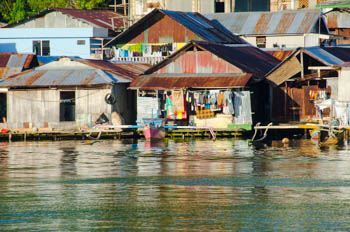
Tenaya
October
2013
Part Two
Jayapura, Papua, Indonesia
| |
| HOME |
| About Tenaya |
| About Us |
| Latest Update |
| Logs from Current Year |
| Logs from Previous Years |
| Katie's View |
| Route Map |
| Links |
| Contact Us |
![]()
October 18, 2013
02 31'.19S 140 43'.84E
"Is Jayapura still a shithole?" a Facebook friend asks. I think about it while I eat my fried noodles with veggies and seafood. The smells of the city assault my nose and it is dirty with plastic bottles piled in the gutters and floating in the harbor. It is grimy and crowded, yes, but in an interesting and even endearing way. No, I would not call it a shithole.
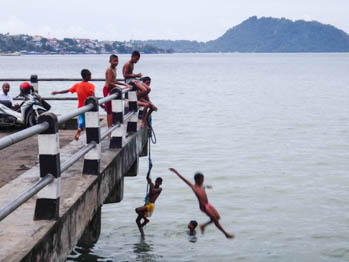
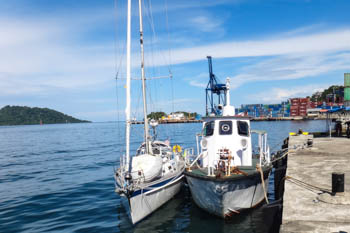
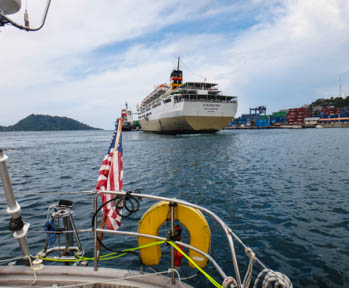
It's never dull trying to find our way around a new city when we don't speak the language and don't have a dictionary. We arrive Saturday morning, October 5 and tie Tenaya to the smaller of the two Coast Guard boats in front of the Harbormaster. Soon we are off in search of Immigration to check-in.
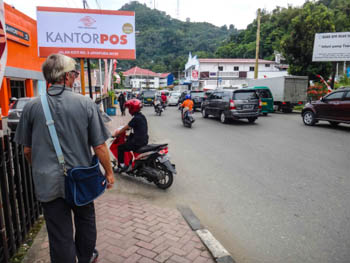
Ghersom is a captain of the big, new Coast Guard boat and Iwan is the captain of the old, dilapidated one we are tied to. Ghersom speaks English well and gives us directions. He thinks about it for a while and changes his mind a couple of times, a safe bet it won't be easy to find. I ask him to write down the name of the landmark hotel he gives us and we head off in the direction he points in the stifling heat. Jim wears long pants and I wear a skirt because brown nosing can't hurt with government officials.
There are two main streets that run parallel to the harbor in the center of Jayapura. Two others bisect these. When we reach the street with the hotels we turn up but do not find Hotel Dafansoro. I ask a policeman sitting in the shade of an awning and he points across the street. Right. We feel stupid and blame it on sleep deprivation. He says Immigration is just a little further along. A man listening to our conversation offers to lead us.
The immigration offices are closed but construction workers are revamping the entrance. They find a man who is there on his day off. He leads us to his office and says, "May I see your passports?" We hand them over. "May I see you CAIT?" We say we don't have one. He frowns. This cruising permit is mandatory for yachts entering Indonesia. We explain that we did not mean to come to Indonesia. We were sailing from Papua New Guinea to Palau, ran into bad weather, broke a part on our boom, and had to come here to fix it and get more fuel. We decide to copy the guide book and draw our intended and actual routes for him and the other officials.
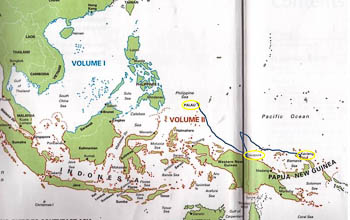
He perks up at the mention of a broken part. "So it is an emergency?" he asks. "Oh yes," we answer. He shows us the CAIT of another yacht and explains that it is essential to have to sail in Indonesian waters. We say we don't want to sail anywhere else in this country, just fix our boat, buy fuel and be on our way at the next good weather window. He seems offended that we weren't coming to Indonesia so I say we are traveling from PNG to Palau, then the Philippines and on to Borneo. We will enter Indonesia in Kalimantan, on Borneo, next year. That is our plan. I am animated when I say, "Indonesia in 2014. Not now! Then we will have our CAIT." He understands and finally smiles. He calls a colleague who arrives with his wife. Her head is wrapped in the Muslim fashion. This man takes our passports and says he needs to process them on Monday. He won't give them back, but gives us a receipt. Then he gives us a ride to the boat so he can photograph the damage.
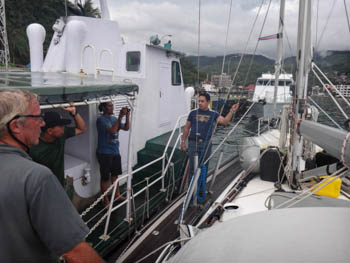
After the Immigration official and his wife leave Anton and Dadang from the Navy come dressed in T-shirts, shorts and flip flops. We wonder if they are really from the Navy but ask if they would like to come inside and have a look. Anton asks a few casual questions about the boat and then, "Do you have weapons on board? Do you have narcotics?" As he climbs through the companionway he asks to see our ship's papers. He and Ghersom look at them carefully.

Before Jim can repair the pin at the boom Iwan has a friend come look at it. With no English spoken, he makes it clear he can repair the old pin. He uses a cut off drill bit to replace the lost retaining post, pulls a portable welder out of his backpack and welds them together. Then he hops on Tenaya and soon the boom is reattached and perhaps better than new. The man will not tell us his name or take any payment so Jim gives him a Tenaya crew T-shirt.
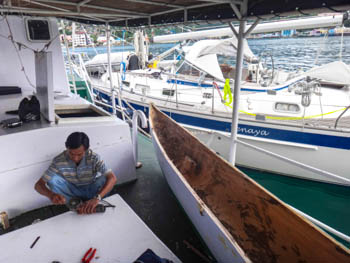

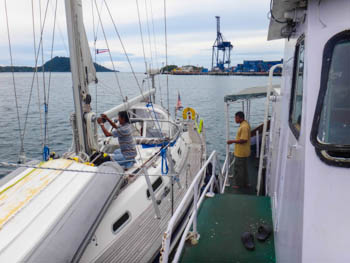
He has been so helpful that Jim asks him where we can buy solar, the Indonesian word for diesel. He confers with Iwan and says we can get it from the Coast Guard boat. Great! It has to be good quality if they use it. Jim tells them we need 140 liters and they begin filling our 20 liter jugs. Iwan, the repairman and another man fill and ferry while Jim dumps them into our tank. I am dizzy, hot and sweating like crazy so am sprawled out on our bed with the fan on and a spray bottle nearby. No help whatsoever.
Iwan charges us 9000 rupiah per liter. That is about 90 cents, 10 cents more than the local subsidized price. It's less than half the price we paid in PNG. By Sunday afternoon our boom is fixed and Tenaya is refueled. We are ready to go but do not want to leave just yet. We've got a new city to explore!
Each person we meet is helpful and friendly. They don't want bribes or anything out of the ordinary, they seem happy to just have their photo taken on the boat with one of us or alongside our American flag.
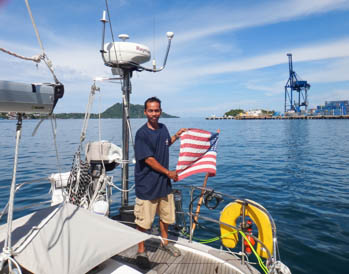
Papua shares the second largest island in the world, after Greenland, with Papua New Guinea. Each time new colonizers come the land gets a new name. The simple version is that first the Portuguese came followed by the Spanish and then the Dutch. In 1962 Indonesia took over and in 1973 named this area Irian Jaya. Native Papuans share nothing ethnically or culturally in common with Indonesians and still refer to this land as Papua.
Many indigenous people would prefer independence from Indonesia. Organisasi Papua Merdeka (Free Papua Organisation, OPM) guerilla movement began in 1965 and still exists today. Every few years an uprising takes place but the police are quick to quell it. Over one million non-Papuans live here so it is doubtful the OPM will ever gain independence.
A large percentage of the population is Muslim, mostly those of Indonesian descent. The Christian missionaries have made more inroads with the indigenous Papuans. We meet people of both races and religions. All are friendly and hospitable.
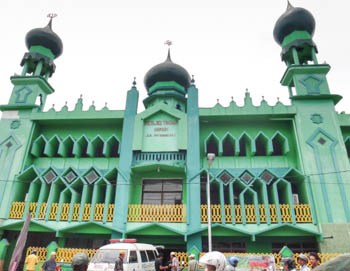
We go back to Immigration on Monday to collect our passports. We sit next to another white couple and soon start up a conversation. They are missionaries who have just completed translating the New Testament to the newer, informal Indonesian language. It had been translated into the formal language, but many people do not read that. Next they will tackle the Old Testament.
They are called, do their business and leave. Another white couple comes up and sits near us. They, too, are missionaries. They too are called, do their business and leave. We wonder if people think we are missionaries.
It takes four hours for our business to be completed. We have been granted 30 day Visas on Arrival but are told we must leave once the repair is completed. We have to take a taxi to a specific bank to pay for the VOA and bring the receipt back to Immigration. It costs $50 USD per person. The bank has a policy of not accepting folded $100 bills. I show the nice man that all my money is folded, that's how it fits in my small wallet. Finally they take it.

Three dozen chairs are lined up in three rows along one side of the cavernous work space. Two rows are fill with older Papuan men dressed in the beautifully printed and tailored shirts reserved for important occasions. A younger man seems to be coordinating them. Jim and I take seats in the back row. I notice a man's necklace because it looks like Jim's shell money necklace from Nusalik. The man shows me that it is a cord to a small pouch he carries his smart phone in. I smile and nod. He nudges the man in front of him and says something. He shows me his and then gives it to me. I admire it and hand it back but he waves for me to keep it. My eyes widen and my face does a happy dance. Jim asks if he can take a picture of the two men with me. It's clear they are pleased. When the others see us taking photos and looking at the screen they pull out their phones and start snapping away. The immigration workers look amused.

All the officials want us to stamp the forms with our boat stamp. We don't have a boat stamp. We've managed to sail 38,000 miles without ever needing one but now we must have one made. We go to a little hole-in-the-wall and it is ready in one hour. We kill time talking to the guys in the other shops and taking photos of the food stand on the back of a motorcycle.
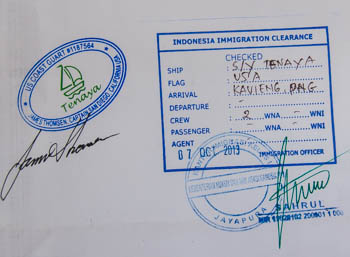

Hoping to get internet access on the boat, we visit the Telkomsel office to buy a dongle and a SIM card. A cheerful young woman named Happy advises us not to because work is being done on the system and the service is not reliable. We decide to have lunch each day at the air conditioned Hotel Yasmin and use their free wifi instead. After five days of waiting on us the server finally asks where we are staying. He is surprised to learn we live on a yacht. That evening we print a picture of Tenaya to show people who are curious.
Sludge and rubbish float on the surface of the water around Tenaya. It is a glowing testament to Spectra that we are able to make good water but we toss the filters immediately. We are happy in this spot, though, as it is walking distance to Hotel Yasmin and to the market that sells Fuji apples, Magnum ice cream bars and Jim's coffee.
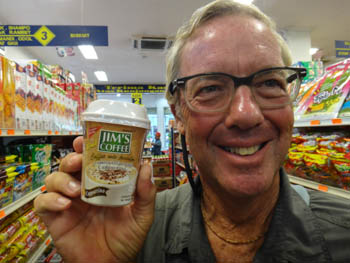
It's noisy in Jayapura. There is a constant chorus of beeping taxi and motorcycle horns and calls to prayer begin at 4:15 am and don't end until after 7:00 pm. There are two mosques, maybe three nearby. Each blasts melancholic music. Often at the same time.
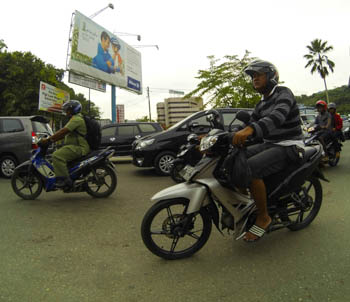
There are a lot of motorcycles and colored taxis, spelled taksis here. The system is ingenious. There are small color-coded minivans, most with their doors propped open. To go around the center of town you get in a white one. To go west hop in a blue one. If you want to go east, hail a green one. Most rides will cost 3,000 rupiah, about 30 cents. Most roads are one or two lanes but at any given time there may be four vehicles abreast.
We didn't see any accidents and the only ambulance we noticed was the one we rode in to meet the Health official. His office is in a plush new building halfway to the airport. Instead of driving to the shabby satellite office near the port, he had the ambulance driver bring us to him.
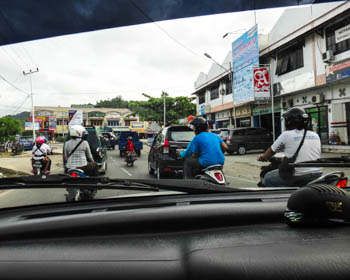
I have vertigo so once we are cleared in with all the authorities, we search out an Ear, Nose and Throat specialist. The Health officer has given us the name of a doctor he recommends. He works at the hospital during the day and at a private clinic at night. We take a blue taxi up to the hospital hoping to see him but he has gone for the day. At 5:00 pm we go to the Apotik Kimia Farma Cendrawasih and I put my name on the waiting list. We sit in a crowded room with others waiting to see the five doctors there.
At 7:20 pm the receptionist for Dr. Ronny Simanjuntak calls me in. I tell him about my dizziness and lightheadedness and that I have been SCUBA diving recently. He examines my ear while I watch the video on a screen. Hmm, he says. Then he asks me to sit in a soundproof room and gives me earphones. I'm to press a button each time I hear a beep. He tests my left ear first, the problem ear, then the right. When I go out I see two graphs on a computer screen. The second is a straight horizontal line. The first is horizontal for the first half and then drops dramatically with a slight upward slope at the very end. He says this is not good. I've got a problem with my inner ear. He gives me a prescription for two medications and says I will feel better in a few days. The pharmacist can only fill one of the prescriptions so the doctor issues another script.
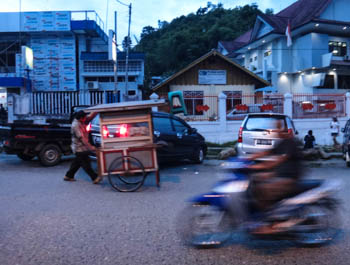
Near the port is a small stand on the side of the road that sells reef fish each afternoon. People pull up on their motorcycles and load up for dinner. There are food stands, food carts and scanty food shacks everywhere. The food is cheap and the rats are plump.
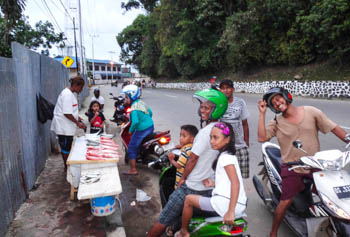

We are not pleased the day Iwan says we need to move. The water is getting too rough and his boat is bashing against the wall. He says to follow him to Dock 9, Bitang.


We cross the harbor and head into a small bay at the far end. The water's edge is covered with houses on stilts. Many have the motorized canoes with double outriggers tied in front. There is a long open building with a few modern recreational motor boats moored to a wooden dock. Dock 9. A Navy boat is tied to a big, modern Rescue Boat. Iwan pulls up to a fishing boat behind them and we secure Tenaya to his boat again.
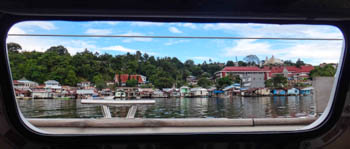
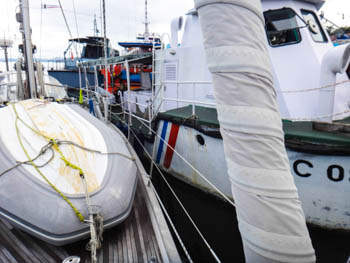
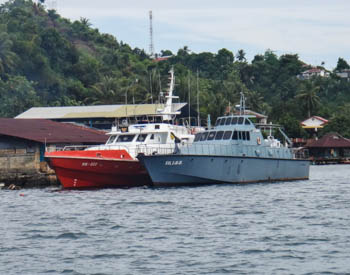
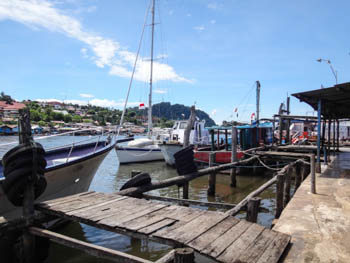
Iwan introduces us to a man who will provide security. A short time later we hear someone on deck and go up to find several men on the Coast Guard boat looking at Tenaya. One man is standing on our deck. I ask him to leave and try to explain this is our home but can't find the words in our Lonely Planet guide. He looks sheepish and climbs off. Iwan and the security guard are nowhere to be found.
It is quickly evident that this place is much more public than the wall by the harbormaster. Men congretate on the Coast Guard boat to fish and smoke. A couple of kids are playing at the stern and I wave to them. In no time there are dozens of exicted, noisy kids clambering to see into our cockpit, down the companionway and in all the portside windows. We usually invite just about anyone onboard but not here. There are way too many people. Eventually I have to spread fabric down from the bimini and across the windshield so we can sit in the cockpit without being stared at. I feel like a friggin' fish in a glass bowl! The curtains on portside remain closed all day and all night.
We are a long way from the center of town now so must take the blue taxis to town. It still costs 3,000 rupiah. We go to the three-story air conditioned Jayapura Mall and buy some fresh fruit and crackers and see a store selling gorgeous fabric. I go on a spree because the prices are low. So friends and family, guess what your next souvenirs will be?
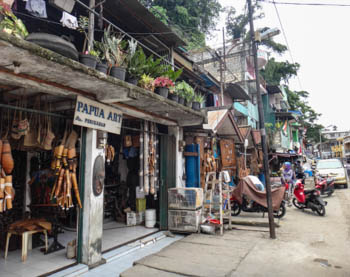
Another day we go to Hamadi three kilometers south of the city center. There are several Papuan craft shops here selling carved wooden statues, stone axes, bark paintings, woven bags, drums, penis gourds and a multitude of things made from dead animal parts.

Jim is intrigued by the weapon made from a dead cassowary. These tall, flightless birds have a unique crown and are protected in Australia but obviously not here in Papua. The handle is the bird's head and the dagger is a leg bone chiselled to a sharp point. It's actually pretty cool in a National Geographic kind of way but I could not imagine it sitting on a shelf when we get back to Mammoth. I'm certain our son, who will not eat meat of any sort, would not approve.
The shopkeeper takes some delight in dressing me up in as many dead things as he can find. He ties a headdress around my forehead made from an entire Bird of Paradise, wings, feathers, head, beak and all. Gum shells make a pretty pattern on the band. It is heavy and itchy and I picture all kinds of creepy things crawling into my hair.
He drapes fabric woven from dead plants over my shoulders and wraps more around my waist. He ties bands of feathers around both biceps and hangs a heavy shell necklace around my neck. I pose just long enough for Jim to take a few photos then can't get this stuff off fast enough. I wonder if he does this to all the middle aged white women tourists. We buy a wood carving and some benign bracelets and are on our way.

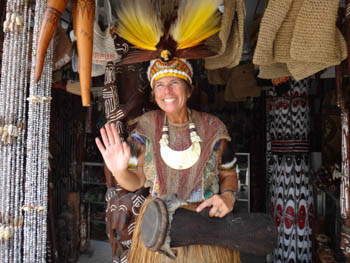
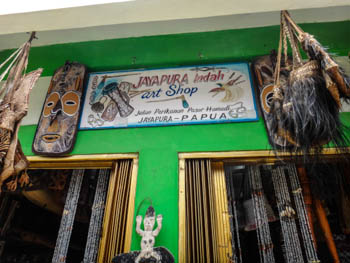
There is a vast open air market across the street that sells, from what I can see, just about everything. Bean sprouts are piled in small mounds and peppers are tied together. Mass quantities of greens, carrots and tubers are corralled in bins. We buy some small green tart citrus fruit with orange flesh. Added to mango concentrate, they make a delicious juice. We avoid the dyed chicks. Apparently the SPCA has no presence in Papua.
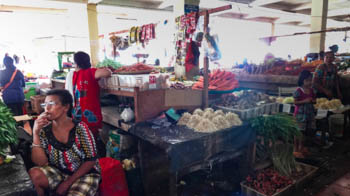
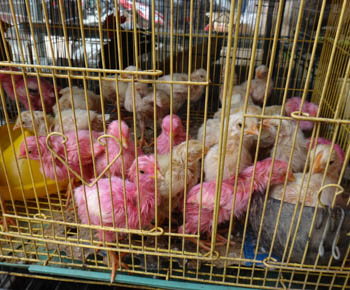
Our kayak sprung a leak in PNG and Jim tried to repair it but it wouldn't hold air so we packed it up and stowed it away. He pulls it out again at Dock 9 and Iwan helps him glue it again. They duct tape over the repair and let it sit. It seems to hold and we consider paddling around the neighborhood to get a closer look at the houses and small boats. The water quality makes us think twice. If it doesn't hold, we don't want to be swimming in this.

One evening a long boat pulls up between us and the military boats. A guy holds it in place while the other carries fish up to the Rescue Boat. We take pictures and print one for them before they leave.

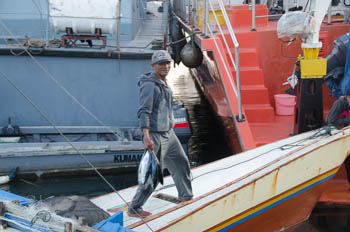
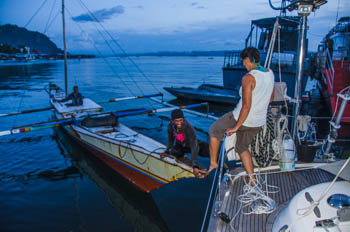
A few days later it is a holiday, the end of Ramadan. It is windy and the bay is choppy. Iwan says he wants to leave and take his friends fishing. He will be back at 10 pm. We let him out and retie to the fishing boat. We can't remember the last time we stayed up until 10 pm.
Joyo is a mechanic on the Navy boat. It has been his home for 8 years. He says his name on Facebook is after a pirate from the Pirates of the Caribbean so I go down below and get him some skull and crossbones head garb. He puts them on and doesn't take them off.
He gives me an Indonesian to English pocket dictionary and later he gives me his dog tags. There is no ID tag, but a design representing Allah and the tag of his first ship. I am touched. This is the only religious thing onboard Tenaya. I hope it keeps us safe when we continue our passage north towards the typhoons.

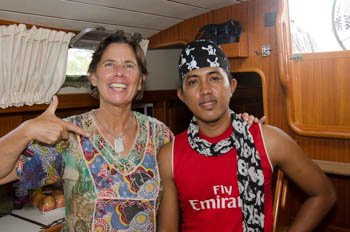
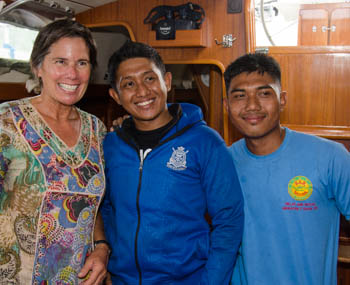
Udin and Ahmad from the Rescue Boat come over too and have a tour below. None of them have been inside a sailboat before. After we all take photos I say, " Well, you've seen our boat, now can we see yours?" I am surprised when they say yes.
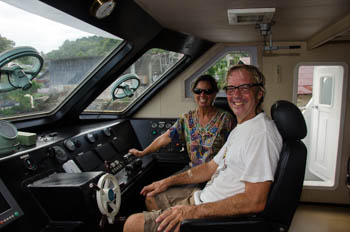
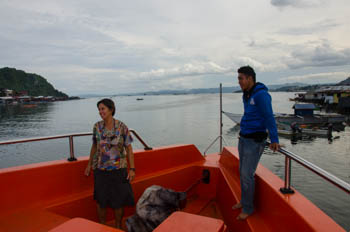
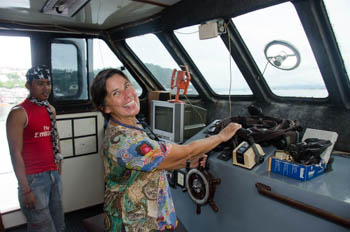
The weather looks good to leave on October 17 so the day before we go to Immigration, the Coast Guard and the Harbormaster to check-out. The harbormaster says he can act for the Health Officer which saves us a trip. But he says he must see Tenaya to make sure our boom is fixed. Seriously. Could he possibly think we would want to sail 800 miles with it still broken?
We take a taxi back to the boat, wait for him, and take another taxi back to his office where we wait. I sit outside and play 'crash the cars' with Ghersom's young son. His wife and some of their colleagues come out and talk. Just as Jim emerges a big bus pulls into the lot. A lady Coast Guarder says it's her husband and offers us a ride to the blue taxi stand.

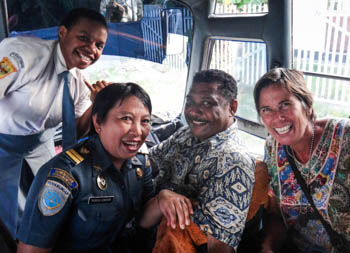
That night I bake brownies for the the crews of all the boats. The next morning we deliver them and say good-bye. We like the guys on the rescue boat but hope we do not see them once we leave. We do not want to need their services!
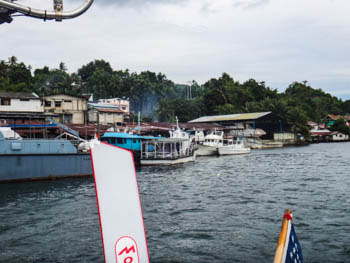
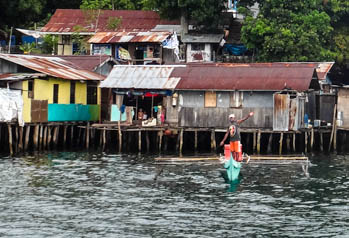

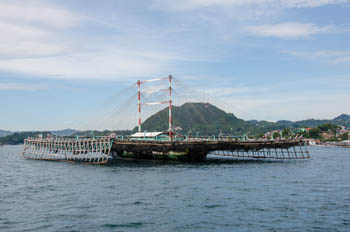
People wave good-bye as we motor out of the harbor. On the way out we pass more large fishing boats and guys wave from them. Americans are a novelty in Jayapura and a sailboat is even more of a novelty. We still have not seen another one since we left Australia three months ago.
Go to October 2013 Part Three - A Passage for the Birds - Jayapura, Indonesia to Palau
